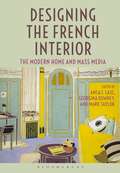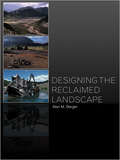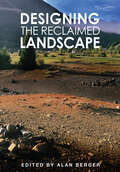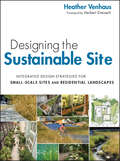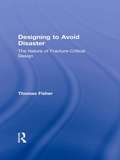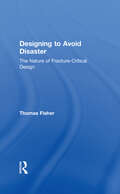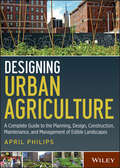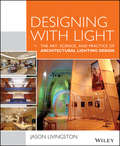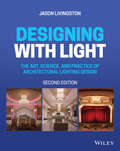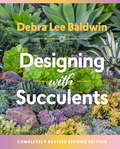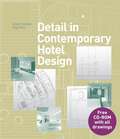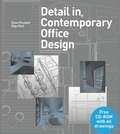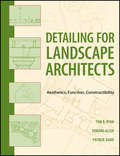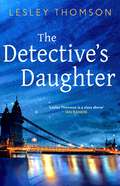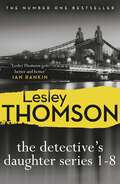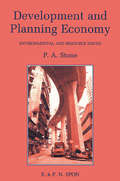- Table View
- List View
Designing the French Interior: The Modern Home and Mass Media
by Anca I. Lasc Georgina Downey Mark TaylorDesigning the French Interior traces France's central role in the development of the modern domestic interior, from the pre-revolutionary period to the 1970s, and addresses the importance of various media, including drawings, prints, pattern books, illustrated magazines, department store catalogs, photographs, guidebooks, and films, in representing and promoting French interior design to a wider audience. Contributors to this original volume identify and historicize the singularity of the modern French domestic interior as a generator of reproducible images, a site for display of both highly crafted and mass-produced objects, and the direct result of widely-circulated imagery in its own right. This important volume enables an invaluable new understanding of the relationship between architecture, interior spaces, material cultures, mass media and modernity.
Designing the French Interior: The Modern Home and Mass Media
by Anca I. Lasc Georgina Downey Mark TaylorDesigning the French Interior traces France's central role in the development of the modern domestic interior, from the pre-revolutionary period to the 1970s, and addresses the importance of various media, including drawings, prints, pattern books, illustrated magazines, department store catalogs, photographs, guidebooks, and films, in representing and promoting French interior design to a wider audience. Contributors to this original volume identify and historicize the singularity of the modern French domestic interior as a generator of reproducible images, a site for display of both highly crafted and mass-produced objects, and the direct result of widely-circulated imagery in its own right. This important volume enables an invaluable new understanding of the relationship between architecture, interior spaces, material cultures, mass media and modernity.
Designing the Reclaimed Landscape
by Alan BergerThe first practical yet in-depth exploration of how to reclaim the post-industrial landscape, this volume includes excellent case studies by practitioners and policy makers from around the US, giving first rate practical examples. The book addresses new thinking about landscape, which applies new techniques to the task of transforming outdated and disused post-extraction landscapes through design. In the USA alone, there are nearly 500,000 abandoned mines in need of reclamation and this book provides the first in-depth guidance on this real and pressing issue. Drawing on the work of the well-known Project for Reclamation Excellence at Harvard's Graduate School of Design, this volume outlines the latest design thinking, theory and practice for landscape planners, landscape architects and designers and others interested in maximizing the future potential of reclaimed land.
Designing the Reclaimed Landscape
by Alan BergerThe first practical yet in-depth exploration of how to reclaim the post-industrial landscape, this volume includes excellent case studies by practitioners and policy makers from around the US, giving first rate practical examples. The book addresses new thinking about landscape, which applies new techniques to the task of transforming outdated and disused post-extraction landscapes through design. In the USA alone, there are nearly 500,000 abandoned mines in need of reclamation and this book provides the first in-depth guidance on this real and pressing issue. Drawing on the work of the well-known Project for Reclamation Excellence at Harvard's Graduate School of Design, this volume outlines the latest design thinking, theory and practice for landscape planners, landscape architects and designers and others interested in maximizing the future potential of reclaimed land.
Designing the Sustainable Site: Integrated Design Strategies for Small Scale Sites and Residential Landscapes
by Heather L. VenhausThe full-color, practical guide to designing sustainable residential landscapes and small-scale sites "Going green" is no longer a choice; it's a necessity. Developed landscapes have played a significant role in exacerbating the environmental and social problems that threaten humanity; however, they can also be part of the solution. Designing the Sustainable Site: Integrated Design Strategies for Small-Scale Sites and Residential Landscapes gives site designers and landscape architects the tools and information they need to become a driving force in the quest for sustainability. Advocating a regenerative design approach in which built landscapes sustain and restore vital ecological functions, this book guides readers through a design process for new and redeveloped sites that not only minimizes damage to the environment but also actively helps to repair it. Designing the Sustainable Site: Assists designers in identifying and incorporating sustainable practices that have the greatest positive impact on both the project and the surrounding community, within a regional context Uses photographs, sketches, and case studies to provide a comprehensive look at successful green landscape design Illustrates how sustainable practices are relevant and applicable to projects of any size or budget Demonstrates how built environments can protect and restore ecosystem services Explains the multiple and far-reaching benefits that sustainable design solutions can provide Assists project teams in fulfilling credit requirements of green building assessment tools, such as LEED, BREEAM, or SITES With attention to six global environmental challenges—including air pollution, urban flooding and water pollution, water shortages, invasive species, and loss of biodiversity—along with guidance on how to meet these challenges, Designing the Sustainable Site is a practical design manual for sustainable alternatives to small-scale site and residential landscape design.
Designing the Sustainable Site, Enhanced Edition: Integrated Design Strategies for Small Scale Sites and Residential Landscapes
by Heather L. VenhausThe full-color, practical guide to designing sustainable residential landscapes and small-scale sites "Going green" is no longer a choice; it's a necessity. Developed landscapes have played a significant role in exacerbating the environmental and social problems that threaten humanity; however, they can also be part of the solution. Designing the Sustainable Site: Integrated Design Strategies for Small-Scale Sites and Residential Landscapes gives site designers and landscape architects the tools and information they need to become a driving force in the quest for sustainability. Advocating a regenerative design approach in which built landscapes sustain and restore vital ecological functions, this book guides readers through a design process for new and redeveloped sites that not only minimizes damage to the environment but also actively helps to repair it. Designing the Sustainable Site: Assists designers in identifying and incorporating sustainable practices that have the greatest positive impact on both the project and the surrounding community, within a regional context Uses photographs, sketches, and case studies to provide a comprehensive look at successful green landscape design Illustrates how sustainable practices are relevant and applicable to projects of any size or budget Demonstrates how built environments can protect and restore ecosystem services Explains the multiple and far-reaching benefits that sustainable design solutions can provide Assists project teams in fulfilling credit requirements of green building assessment tools, such as LEED, BREEAM, or SITES With attention to six global environmental challenges—including air pollution, urban flooding and water pollution, water shortages, invasive species, and loss of biodiversity—along with guidance on how to meet these challenges, Designing the Sustainable Site is a practical design manual for sustainable alternatives to small-scale site and residential landscape design.
Designing To Avoid Disaster: The Nature of Fracture-Critical Design
by Thomas FisherRecent catastrophic events, such as the I-35W bridge collapse, New Orleans flooding, the BP oil spill, Port au Prince's destruction by earthquake, Fukushima nuclear plant's devastation by tsunami, the Wall Street investment bank failures, and the housing foreclosure epidemic and the collapse of housing prices, all stem from what author Thomas Fisher calls fracture-critical design. This is design in which structures and systems have so little redundancy and so much interconnectedness and misguided efficiency that they fail completely if any one part does not perform as intended. If we, as architects, planners, engineers, and citizens are to predict and prepare for the next disaster, we need to recognize this error in our thinking and to understand how design thinking provides us with a way to anticipate unintended failures and increase the resiliency of the world in which we live. In Designing to Avoid Disaster, the author discusses the context and cultural assumptions that have led to a number of disasters worldwide, describing the nature of fracture-critical design and why it has become so prevalent. He traces the impact of fracture-critical thinking on everything from our economy and politics to our educational and infrastructure systems to the communities, buildings, and products we inhabit and use everyday. And he shows how the natural environment and human population itself have both begun to move on a path toward a fracture-critical collapse that we need to do everything possible to avoid. We designed our way to such disasters and we can design our way out of them, with a number of possible solutions that Fisher provides.
Designing To Avoid Disaster: The Nature of Fracture-Critical Design
by Thomas FisherRecent catastrophic events, such as the I-35W bridge collapse, New Orleans flooding, the BP oil spill, Port au Prince's destruction by earthquake, Fukushima nuclear plant's devastation by tsunami, the Wall Street investment bank failures, and the housing foreclosure epidemic and the collapse of housing prices, all stem from what author Thomas Fisher calls fracture-critical design. This is design in which structures and systems have so little redundancy and so much interconnectedness and misguided efficiency that they fail completely if any one part does not perform as intended. If we, as architects, planners, engineers, and citizens are to predict and prepare for the next disaster, we need to recognize this error in our thinking and to understand how design thinking provides us with a way to anticipate unintended failures and increase the resiliency of the world in which we live. In Designing to Avoid Disaster, the author discusses the context and cultural assumptions that have led to a number of disasters worldwide, describing the nature of fracture-critical design and why it has become so prevalent. He traces the impact of fracture-critical thinking on everything from our economy and politics to our educational and infrastructure systems to the communities, buildings, and products we inhabit and use everyday. And he shows how the natural environment and human population itself have both begun to move on a path toward a fracture-critical collapse that we need to do everything possible to avoid. We designed our way to such disasters and we can design our way out of them, with a number of possible solutions that Fisher provides.
Designing Urban Agriculture: A Complete Guide to the Planning, Design, Construction, Maintenance and Management of Edible Landscapes
by April PhilipsA comprehensive overview of edible landscapes—complete with more than 300 full-color photos and illustrations Designing Urban Agriculture is about the intersection of ecology, design, and community. Showcasing projects and designers from around the world who are forging new paths to the sustainable city through urban agriculture landscapes, it creates a dialogue on the ways to invite food back into the city and pave a path to healthier communities and environments. This full-color guide begins with a foundation of ecological principles and the idea that the food shed is part of a city's urban systems network. It outlines a design process based on systems thinking and developed for a lifecycle or regenerative-based approach. It also presents strategies, tools, and guidelines that enable informed decisions on planning, designing, budgeting, constructing, maintaining, marketing, and increasing the sustainability of this re-invented cityscape. Case studies demonstrate the environmental, economic, and social value of these landscapes and reveal paths to a greener and healthier urban environment. This unique and indispensable guide: Details how to plan, design, fund, construct, and leverage the sustainability aspects of the edible landscape typology Covers over a dozen typologies including community gardens, urban farms, edible estates, green roofs and vertical walls, edible school yards, seed to table, food landscapes within parks, plazas, streetscapes and green infrastructure systems and more Explains how to design regenerative edible landscapes that benefit both community and ecology and explores the connections between food, policy, and planning that promote viable food shed systems for more resilient communities Examines the integration of management, maintenance, and operations issues Reveals how to create a business model enterprise that addresses a lifecycle approach
Designing Urban Agriculture: A Complete Guide to the Planning, Design, Construction, Maintenance and Management of Edible Landscapes
by April PhilipsA comprehensive overview of edible landscapes—complete with more than 300 full-color photos and illustrations Designing Urban Agriculture is about the intersection of ecology, design, and community. Showcasing projects and designers from around the world who are forging new paths to the sustainable city through urban agriculture landscapes, it creates a dialogue on the ways to invite food back into the city and pave a path to healthier communities and environments. This full-color guide begins with a foundation of ecological principles and the idea that the food shed is part of a city's urban systems network. It outlines a design process based on systems thinking and developed for a lifecycle or regenerative-based approach. It also presents strategies, tools, and guidelines that enable informed decisions on planning, designing, budgeting, constructing, maintaining, marketing, and increasing the sustainability of this re-invented cityscape. Case studies demonstrate the environmental, economic, and social value of these landscapes and reveal paths to a greener and healthier urban environment. This unique and indispensable guide: Details how to plan, design, fund, construct, and leverage the sustainability aspects of the edible landscape typology Covers over a dozen typologies including community gardens, urban farms, edible estates, green roofs and vertical walls, edible school yards, seed to table, food landscapes within parks, plazas, streetscapes and green infrastructure systems and more Explains how to design regenerative edible landscapes that benefit both community and ecology and explores the connections between food, policy, and planning that promote viable food shed systems for more resilient communities Examines the integration of management, maintenance, and operations issues Reveals how to create a business model enterprise that addresses a lifecycle approach
Designing With Light: The Art, Science and Practice of Architectural Lighting Design
by Jason LivingstonA comprehensive introduction to the theory and practice of lighting design Designing With Light: The Art, Science, and Practice of Architectural Lighting Design is a comprehensive introduction to the intelligent use of lighting to define and enhance a space. The book explores all aspects of the process, including aesthetics, technology, and practicalities, in a clear, concise manner designed to provide the reader with a full working knowledge of lighting design. Color illustrations throughout demonstrate the real-world effects of the concepts presented, and the companion website offers video animations and exercises to better illuminate the art and science of lighting. The book addresses the considerations that should be a part of any designer's process, and provides thorough guidance on meeting the various demands with smarter design. Lighting is an essential element of interior design, and despite its ubiquity, is difficult to truly master. A designer with a fundamental and conceptual understanding of light is empowered to create simple, typical spaces, or work intelligently with lighting consultants on more complex projects. Designing With Light contains special discussions on color, light, and health, as well as the latest information on energy efficient lighting, control systems, and other technologies. Topics include: Physics, psychology, and perception of light Current and future lighting technology Communication, documentation, and the design process Sustainability, daylighting, and energy efficiency The book also contains an entire chapter on building and energy codes, as well as practical guidance on photometrics and calculations. Lighting can make or break an otherwise well-designed space, so designers need the background to be able to think intelligently about illumination factors during all stages of the process. With comprehensive coverage and thorough explanation, Designing With Light is a complete resource for students and professionals alike.
Designing With Light: The Art, Science and Practice of Architectural Lighting Design
by Jason LivingstonA comprehensive introduction to the theory and practice of lighting design Designing With Light: The Art, Science, and Practice of Architectural Lighting Design is a comprehensive introduction to the intelligent use of lighting to define and enhance a space. The book explores all aspects of the process, including aesthetics, technology, and practicalities, in a clear, concise manner designed to provide the reader with a full working knowledge of lighting design. Color illustrations throughout demonstrate the real-world effects of the concepts presented, and the companion website offers video animations and exercises to better illuminate the art and science of lighting. The book addresses the considerations that should be a part of any designer's process, and provides thorough guidance on meeting the various demands with smarter design. Lighting is an essential element of interior design, and despite its ubiquity, is difficult to truly master. A designer with a fundamental and conceptual understanding of light is empowered to create simple, typical spaces, or work intelligently with lighting consultants on more complex projects. Designing With Light contains special discussions on color, light, and health, as well as the latest information on energy efficient lighting, control systems, and other technologies. Topics include: Physics, psychology, and perception of light Current and future lighting technology Communication, documentation, and the design process Sustainability, daylighting, and energy efficiency The book also contains an entire chapter on building and energy codes, as well as practical guidance on photometrics and calculations. Lighting can make or break an otherwise well-designed space, so designers need the background to be able to think intelligently about illumination factors during all stages of the process. With comprehensive coverage and thorough explanation, Designing With Light is a complete resource for students and professionals alike.
Designing with Light: The Art, Science, and Practice of Architectural Lighting Design
by Jason LivingstonThe new edition of the popular introduction to architectural lighting design, covering all stages of the lighting design process Designing with Light: The Art, Science, and Practice of Architectural Lighting Design, Second Edition, provides students and professionals alike with comprehensive understanding of the use of lighting to define and enhance a space. This accessible, highly practical textbook covers topics such as the art and science of color, color rendering and appearance, lighting control systems, building codes and standards, and sustainability and energy conservation. Throughout the text, accomplished lighting designer and instructor Jason Livingston offers expert insights on the use of color, the interaction between light and materials, the relation between light, vision, and psychology, and more. Fully revised and updated throughout, the second edition features new chapters on design thinking, common lighting techniques, and lighting economics. Expanded sections on aesthetics, controlling LEDs, light, and health, designing with light, and color mixing luminaires are supported by new case studies, examples, and exercises. Featuring hundreds of high-quality color images and illustrations, Designing with Light: Provides systematic guidance on all aspects of the lighting design process Thoroughly covers color and light, including color perception, color rendering, and designing with colored light Explains the theory behind the practice of architectural lighting design Contains information on cost estimating, life cycle analysis, voluntary energy programs, and professional lighting design credentials Includes an instructor resource site with PowerPoint presentations, test questions, and suggested assignments for each chapter, and also a student site with flashcards, self-evaluation tests, and helpful calculators. Designing with Light: The Art, Science, and Practice of Architectural Lighting Design, Second Edition is perfect for architecture, interior design, and electrical engineering programs that include courses on lighting design, as well as professionals looking for a thorough and up-to-date desk reference.
Designing with Light: The Art, Science, and Practice of Architectural Lighting Design
by Jason LivingstonThe new edition of the popular introduction to architectural lighting design, covering all stages of the lighting design process Designing with Light: The Art, Science, and Practice of Architectural Lighting Design, Second Edition, provides students and professionals alike with comprehensive understanding of the use of lighting to define and enhance a space. This accessible, highly practical textbook covers topics such as the art and science of color, color rendering and appearance, lighting control systems, building codes and standards, and sustainability and energy conservation. Throughout the text, accomplished lighting designer and instructor Jason Livingston offers expert insights on the use of color, the interaction between light and materials, the relation between light, vision, and psychology, and more. Fully revised and updated throughout, the second edition features new chapters on design thinking, common lighting techniques, and lighting economics. Expanded sections on aesthetics, controlling LEDs, light, and health, designing with light, and color mixing luminaires are supported by new case studies, examples, and exercises. Featuring hundreds of high-quality color images and illustrations, Designing with Light: Provides systematic guidance on all aspects of the lighting design process Thoroughly covers color and light, including color perception, color rendering, and designing with colored light Explains the theory behind the practice of architectural lighting design Contains information on cost estimating, life cycle analysis, voluntary energy programs, and professional lighting design credentials Includes an instructor resource site with PowerPoint presentations, test questions, and suggested assignments for each chapter, and also a student site with flashcards, self-evaluation tests, and helpful calculators. Designing with Light: The Art, Science, and Practice of Architectural Lighting Design, Second Edition is perfect for architecture, interior design, and electrical engineering programs that include courses on lighting design, as well as professionals looking for a thorough and up-to-date desk reference.
Designing with Succulents: Growing, Designing, And Crafting With 100 Easy-care Varieties
by Debra Lee BaldwinWith updated plant lists, new photography, and beautiful featured gardens, this 10th anniversary edition of Designing with Succulents is essential for anyone who wants to create a lush garden of waterwise plants.
Detached house with garage (Large Print)
This image shows a front view of a detached house with attached garage. There is a locator dot shown, which will be at the top left of the page when the image is the right way up. The pointed tiled roof of the house fills the upper part of the page, with a chimney sticking up towards the right. Down from the roof the upstairs windows are shown: a large one towards the right and a smaller one to its left. Just to the left of the smaller window, the tiled garage roof slopes down above the wide garage door which has a handle towards its lower centre. The door to the house itself is towards the centre at the bottom of the image. The door is glazed at the top, and the letterbox and door knob are shown. There is a narrow window adjoining the door on the garage side. A large window is shown in the lower right of the image, and all the windows have sills.
Detached house with garage (UEB Contracted)
This image shows a front view of a detached house with attached garage. There is a locator dot shown, which will be at the top left of the page when the image is the right way up. The pointed tiled roof of the house fills the upper part of the page, with a chimney sticking up towards the right. Down from the roof the upstairs windows are shown: a large one towards the right and a smaller one to its left. Just to the left of the smaller window, the tiled garage roof slopes down above the wide garage door which has a handle towards its lower centre. The door to the house itself is towards the centre at the bottom of the image. The door is glazed at the top, and the letterbox and door knob are shown. There is a narrow window adjoining the door on the garage side. A large window is shown in the lower right of the image, and all the windows have sills.
Detached house with garage (UEB uncontracted)
This image shows a front view of a detached house with attached garage. There is a locator dot shown, which will be at the top left of the page when the image is the right way up. The pointed tiled roof of the house fills the upper part of the page, with a chimney sticking up towards the right. Down from the roof the upstairs windows are shown: a large one towards the right and a smaller one to its left. Just to the left of the smaller window, the tiled garage roof slopes down above the wide garage door which has a handle towards its lower centre. The door to the house itself is towards the centre at the bottom of the image. The door is glazed at the top, and the letterbox and door knob are shown. There is a narrow window adjoining the door on the garage side. A large window is shown in the lower right of the image, and all the windows have sills.
Detail in Contemporary Hotel Design (Detailing for Interior Design)
by Drew Plunkett Olga ReidHotel interiors need to satisfy the imaginations of their customers and whet the appetite for a return visit or recommendation, and the design that gets the formula right will do as much to prolong the life of the business as the service delivered within the hotel. This book explores in detail 36 of the best recent hotel interior design schemes, featuring projects by leading architects from around the world. The book is divided into three sections embracing newly built and refurbished hotels as well as conversions.Each project includes photographs as well as detailed drawings and plans, where appropriate, as well as informative text describing the design concept and process. A bonus CD contains drawings featured in the book, in both eps and dwg (generic CAD) formats.
Detail in Contemporary Office Design (Detailing for Interior Design)
by Drew Plunkett Olga ReidOffice design has changed significantly over the last few years and is now one of the most innovative areas of interior design. It used to be the case that only the public spaces of an office were creatively designed, but increasingly the staff areas are seen as key reflections of the company brand as well. In more radical offices, there is also a growing belief in the importance of work areas as social spaces and a blurring of the distinction between work and recreation.This book explores in detail 42 of the best recent office design schemes, featuring projects from leading architects around the world. Each project includes photographs as well as detailed drawings and plans, where appropriate, in addition to informative text describing the design concept and process. A bonus CD contains drawings featured in the book, in both eps and dwg (generic CAD) formats.
Detailing for Landscape Architects: Aesthetics, Function, Constructibility
by Thomas R. Ryan Edward Allen Patrick J. RandThe new industry standard on landscape architectural detailing Detailing for Landscape Architects takes the reader on an educational journey across three major areas of landscape architectural detailing—aesthetics, function, and constructibility—to demonstrate how powerful design patterns can transform thematic ideas into awe-inspiring built realities. Richly illustrated examples accompany concise discussions of a varied blend of landscape design/detailing issues such as water movement, soil environments, articulating structures and construction assemblies, life cycle costing, sustainability, health and safety, and more. This book approaches the subject of detailing in a systematic manner, and provides a balanced framework for design and workmanship that conveys the essence of the built landscape. Detailing for Landscape Architects shows how details can: Reinforce design ideas through the continuity and discontinuity of patterns Actively contribute to the overall form or geometry of the design Be designed to be durable and flexible while enhancing the entire design Gracefully accommodate the natural growth and change of plant materials Anticipate maintenance needs to minimize future disruptions Maximize their cost effectiveness through understanding their function while designing to meet those functions Including chapters that apply detail patterns to the design of an urban plaza, a roof deck, and a residence, Detailing for Landscape Architects offers guidance on solving specific technical requirements, while preserving and enhancing the visual qualities that celebrate innovation, and carry forth a timeless quality of building.
Detailing for Landscape Architects: Aesthetics, Function, Constructibility
by Thomas R. Ryan Edward Allen Patrick J. RandThe new industry standard on landscape architectural detailing Detailing for Landscape Architects takes the reader on an educational journey across three major areas of landscape architectural detailing—aesthetics, function, and constructibility—to demonstrate how powerful design patterns can transform thematic ideas into awe-inspiring built realities. Richly illustrated examples accompany concise discussions of a varied blend of landscape design/detailing issues such as water movement, soil environments, articulating structures and construction assemblies, life cycle costing, sustainability, health and safety, and more. This book approaches the subject of detailing in a systematic manner, and provides a balanced framework for design and workmanship that conveys the essence of the built landscape. Detailing for Landscape Architects shows how details can: Reinforce design ideas through the continuity and discontinuity of patterns Actively contribute to the overall form or geometry of the design Be designed to be durable and flexible while enhancing the entire design Gracefully accommodate the natural growth and change of plant materials Anticipate maintenance needs to minimize future disruptions Maximize their cost effectiveness through understanding their function while designing to meet those functions Including chapters that apply detail patterns to the design of an urban plaza, a roof deck, and a residence, Detailing for Landscape Architects offers guidance on solving specific technical requirements, while preserving and enhancing the visual qualities that celebrate innovation, and carry forth a timeless quality of building.
The Detective's Daughter: A gripping Sunday Times crime club thriller to lose yourself in (The Detective's Daughter #1)
by Lesley ThomsonAs winter closes its grip on snow-bound London, a cleaner determines to solve the case that her detective father never could. A Kindle number one bestseller. It was the murder that shocked the nation. Kate Rokesmith, a young mother, walked to the banks of the Thames with her three-year-old son. She never came home.For three decades, the case file has lain, unsolved, in the corner of an attic. Until the detective's daughter, Stella Darnell, starts to clear out her father's house after his death...Reviews for The Detective's Daughter: 'A haunting novel about loss and reconciliation, driven by a simple but clever plot' Sunday Times 'This book has a clever mystery plot – but its excellence is in the characters, all credible and memorable, and in its setting in a real West London street, exactly described' Literary Review 'A thoughtful, well-observed story... It reminded me of Kate Atkinson' Scott Pack 'A cerebral thriller... Evokes chills from more than just the frigid winter nights' Forward Reviews Magazine 'Lesley Thomson gets better and better' Ian Rankin
The Detective's Daughter Series Boxset (The Detective's Daughter)
by Lesley ThomsonA complete e-Book boxset of the novels in Lesley Thomson's bestselling Detective's Daughter series.Stella Darnell, a cleaner, is the detective's daughter. When her father died, she discovered old case files in his attic while clearing out his house. Now she has devoted herself to solving crimes that were once thought unsolvable, assisted by her friend Jack, a tube driver.Follow Stella and Jack's story with this complete eBook boxset, including books 1–8:The Detective's Daughter Ghost Girl The Detective's Secret The House with No Rooms The Dog Walker The Death Chamber The Playground MurdersThe Distant Dead The first novel in the series, The Detective's Daughter, became an ebook phenomenon in 2013, staying at number 1 in the digital charts for 3 months. Since then, the series has gone on to sell 800,000 copies worldwide.'Lesley Thomson is a class above' Ian Rankin'Stella Darnell is without doubt one of the most orginial characters in British crime fiction'Crime Review
Development and Planning Economy: Environmental and resource issues
by P.A. StoneThis book describes in detail how the property market operates, giving a clear picture of the economics of development and the way which development issues are defined by (and in their turn have an effect on) community and individual needs. By describing how the market works and explaining the factors which need to be analysed, the author aims to improve decision-making techniques and machinery.
